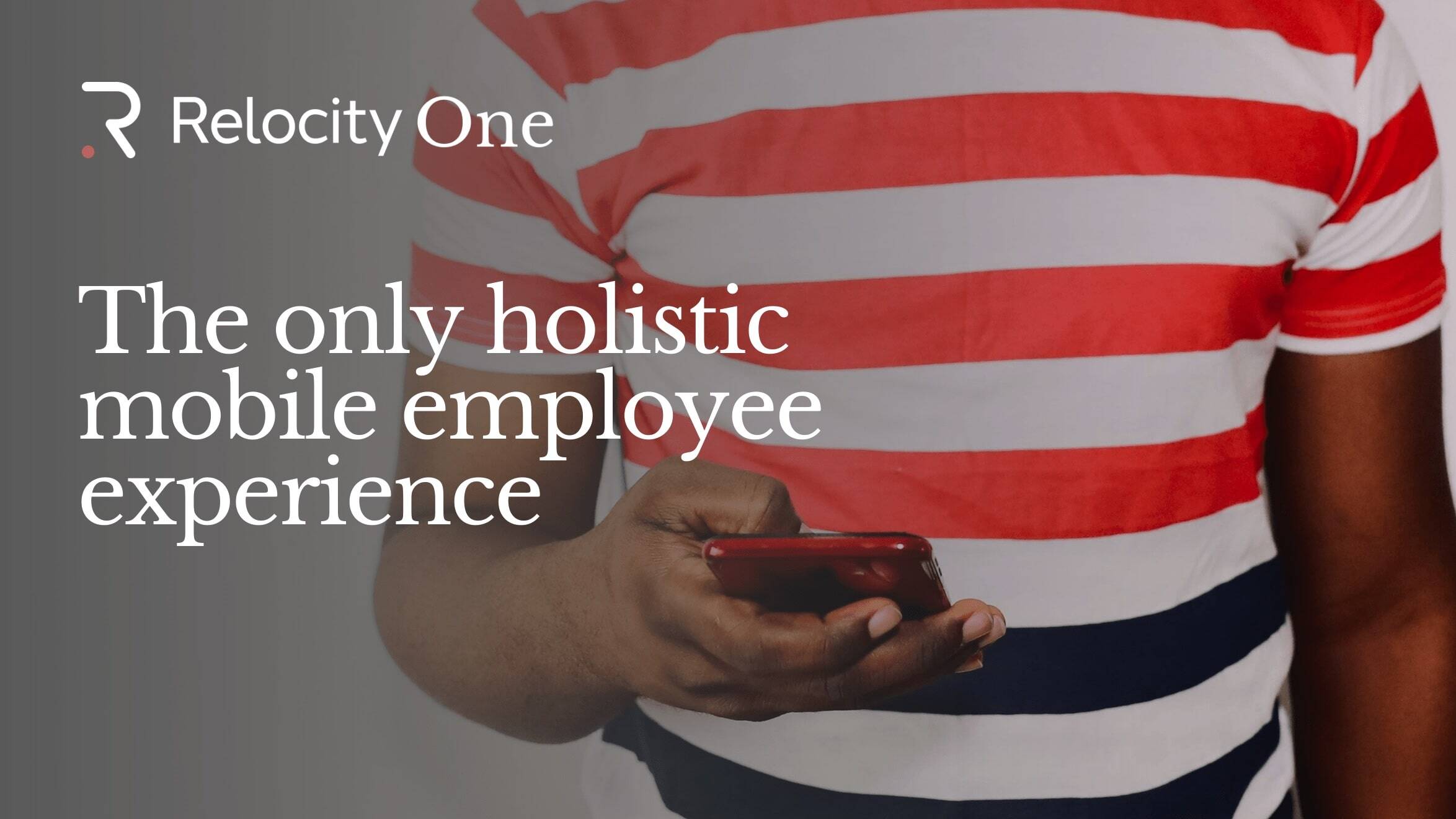Thinking Outside the Box(es) | Relocity
Enhance Your Talent Relocation Package In the mobility business, “relocation” has typically meant moving new hires and their families from one place,...
In our fast-paced world, mobile employee experience is a make-or-break factor in global mobility program success. As mobile talent traverse the globe, they encounter countless challenges — from finding the perfect home to navigating logistical hurdles and adapting to new communities and cultures. Meanwhile, employers grapple with safely and efficiently placing the right talent in the right place, all while keeping costs in check.
These critical considerations took center stage at the recent Worldwide ERC Global Workforce Symposium in Boston, Massachusetts, during Relocity's illuminating panel, "Transforming the Mobile Employee Experience through Technology." This engaging panel, led by Relocity Senior Vice President of Partnerships, William Taylor, featured industry experts Emily Stirling from HubSpot, Christopher Chalk from Graphic Packaging, and Tanya Mariottini from Twilio, who shared deep insight into the transformative power of technology in the realm of global mobility, specifically in reshaping the mobile employee experience. "I've been a loud and intense proponent for using technology for a long time," Stirling said as the discussion kicked off.
Since Relocity’s founding, we’ve regarded technology as critically important, dedicating ourselves to incorporating disruptive technology like artificial intelligence (AI) and machine learning (ML) to streamline global mobility operations and truly improve the mobile employee experience. Embracing disruptive technology as a cornerstone of our offerings has provided countless benefits to our clients and their mobile employees. With technology-driven destination services, our clients:
• Harness the power of data analytics and actionable insights.
• Contain costs.
• Contribute to corporate sustainability objectives.
• Maximizing efficiency.
• Personalize the relocation journey for each individual.
This holistic approach to technology-supported relocation programs not only enhances efficiency but also fosters sustainability, lowers costs, and ensures a deeply personalized and positive mobile employee experience. Join us as we explore how technology is revolutionizing the global mobility landscape and as we unpack three invaluable takeaways from this enlightening event.

Relocity’s panel shed light on where global mobility teams should begin as they embark on the digital transformation journey:
1. Build strong internal relationships. Chalk advised conveying your vision to internal stakeholders as early as possible. Mariottini emphasized the need to develop relationships with the HR tech and finance teams, among others within your organization. She pointed out that these relationships can help sell the value of technology in making internal processes more efficient and enhancing the mobile employee experience. Stirling echoed this sentiment, sharing her experience of securing technology investment dollars by building relationships with stakeholders who hold the pursestrings and creating a compelling business case based on what matters most to them. The panel agreed that it's essential to speak the language of the business to sell leadership on what global mobility needs.
2. Plan for scalability. To ensure long-term success, consider scalability and align your technology roadmap with your guiding principles and organizational priorities. Chalk emphasized the need to think strategically and build a strong foundation for future transformation. "Create the technology roadmap to show not only where you want to end up, but also how all suppliers will be connected," he advised. Stirling added, "We are thinking about how we're getting our information organized in a way that technology is leveraged. We’re thinking about structuring our content, information, and policies in a way that is easier to service in the future.”
3. Automate workflows. Start by identifying workflows that can be automated. "If you can put it on a workflow, you can code it. [We] have big aspirations of what we need to do from a transformation perspective, and we're very dialed into our priorities for building the foundation for that in the future," noted Stirling, who advocates for automating time-consuming tasks. She stressed the importance of pinpointing the moments that truly matter in the employee experience and reducing the time spent on less impactful tasks, enabling global mobility professionals to be more high-touch and empathetic when it counts. Mariottini highlighted that making a strong business case for automation is essential. Explain to leadership that the technology will save not only monetary capital, but also human capital. To garner the necessary attention and resources from leadership for technology implementation, paint a clear picture of how this saved time impacts the customer.
In essence, the path to digital transformation in global mobility starts with cultivating relationships, planning for scalability, and automating workflows. By following these expert insights, global mobility teams can navigate the transition from spreadsheets to cutting-edge technology, ultimately enhancing the mobile employee experience and driving organizational efficiency.

As global mobility teams work to digitally transform their programs, they should be vigilant in selecting technology that possesses two critical capabilities highlighted during Relocity's panel at the symposium:
1. Handling complexity at scale: Stirling emphasized the importance of technology's ability to manage complexity at scale to help transferees understand what they need to do, ultimately boosting the mobile employee experience. In other words, technology should not only streamline processes, but also provide employees with a seamless and comprehensive experience. On the back end, technology should facilitate transparent conversations and help manage the inherent risks associated with global mobility.
2. Supplier consolidation and real-time collaboration: Mariottini shed light on the significance of leveraging technology to consolidate suppliers and their data for mobile employees. She pointed out that consolidation streamlines the entire process by removing the need for mobile employees to remember several passwords to access multiple systems — just to complete relocation tasks. By simplifying this traditionally cumbersome process, mobile employees experience an inherently smoother relocation, and real-time information sharing and collaboration among all parties is enhanced.
In conclusion, global mobility teams should prioritize technology that can handle complexity at scale, consolidate suppliers, and foster real-time collaboration, ultimately enhancing the success of relocation programs and improving the experience for all parties involved. These technological capabilities are integral to successful digital transformation.

The topic of API integrations arose during the panel. The dynamic nature of APIs is invaluable in addressing one of the most significant challenges in the field of mobility: the rapid obsolescence of data as soon as it enters the system. By leveraging APIs, global mobility professionals can ensure access to updated information, making it easier to manage the complex logistics of employee relocation.
However, it's important to acknowledge that not all organizations may have the resources or capability to invest in API integrations and the associated maintenance. In such cases, the alternative approach, as recommended by Chalk, is to utilize automated flat file feeds from suppliers. This solution allows global mobility teams to set up files for initiation without incurring the cost of API integration. Stirling, who has been successfully using automated flat file feeds for several years, emphasizes the importance of not hesitating to request them from suppliers. While this approach may require more frequent updates, it can be a sustainable way to keep essential data current.
In addition to seeking automated flat file feeds, it's crucial to engage with the business technology team to ensure that the data remains relevant. For example, you must consider how you’ll keep information up to date, especially in cases where elements like start dates can quickly change. Chalk points out that internal communication tools like Slack and Microsoft Teams can be used to automate specific data files, motivating the right individuals to take action when necessary.
In summary, while API integrations provide advantages, automated flat file feeds are a practical alternative when resources are constrained. This approach ensures that crucial data remains current and is accessible to global mobility teams, ultimately enhancing the efficiency and success of relocation processes.

Relocity's panel at the Global Workforce Symposium delivered three vital takeaways that are sure to resonate with mobility leaders and professionals. First, panelists emphasized that digital transformation should start with the cultivation of essential internal relationships and the strategic automation of workflows. The panel underscored that technology, when leveraged effectively, can handle complexity at scale and consolidate suppliers, leading to streamlined processes and an improved mobile employee experience. Furthermore, the discussion on the advantages of API integrations versus automated flat file feeds shed light on the practical solutions available to global mobility teams with varying resource capabilities.
These insights, combined with a vision of disruption and adaptation, as eloquently put by Stirling, not only lead to cost savings, but also contribute to sustainability efforts by reducing carbon emissions, as highlighted by Chalk. In this rapidly changing global mobility landscape, the panel's practical strategies provide corporate mobility leaders with ideas on how to elevate their programs, meet customer demands, and navigate this disruptive moment effectively.
As Stirling said, "We have to disrupt ourselves," and she further emphasized that customers' evolving needs and the push for supplier evolution are converging into a disruptive moment in mobility. This insight makes it clear that in embracing digital transformation, global talent mobility teams can not only enhance their operations, but also respond to the demands of a changing world in their quest to help their organizations attract, engage, and retain top talent.
Relocity’s holistic approach to technology-supported relocation programs supports these initiatives of our clients, enhancing efficiency, fostering sustainability, lowering costs, and creating a deeply personalized and positive mobile employee experience.

Enhance Your Talent Relocation Package In the mobility business, “relocation” has typically meant moving new hires and their families from one place,...

Los Angeles, CA – October 22, 2024 – Relocity, a leader in innovative corporate mobility solutions, is excited to introduce Relocity One, a...

Reviewing a painstaking lease agreement in a competitive housing market, ensuring her five-year-old leaves the house in matching socks — it’s all in...
-1.png)